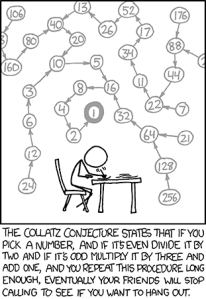 this section contains some experiments on the collatz conjecture which has deep connections to TCS.[4][19] this is the nagging, taunting, ¾-century-unsolved problem for which Erdös semifamously said:
this section contains some experiments on the collatz conjecture which has deep connections to TCS.[4][19] this is the nagging, taunting, ¾-century-unsolved problem for which Erdös semifamously said:
Mathematics is not yet ripe for such problems. —Erdös
also Terrence Tao immediately cites it when referring to “mathematical diseases”[9] and as “One of the most notorious problems in elementary mathematics that remains unsolved”.[7] he compares succeeding on such problems to “winning the lottery” and even somewhat dramatically admonishes/warns against working on such problems, in line with that old canard…
fools rush in where angels fear to tread
maybe appropriately, the following is a work-in-progress & admittedly sketchy.
⭐ ⭐ ⭐
the Collatz conjecture is a great problem to experiment/study on esp with CS based approaches (writing code, visualizing results); its possible/ ultimate/ eventual(?) solution is regarded as very hard—or maybe impossible—by experts. however there are many basic variants of exercises on it that have “correct solutions” that are accessible to undergraduates. it has remarkable/amazing aspects of/connections to many areas of active mathematical & CS research, in a few words, highly crosscutting, suggesting a tip of an iceberg:
- fractals
- chaotic behavior
- dynamical systems
- number theory
- (un)decidability
- busy beaver problem
- automata theory
- Finite state transducer
- random walks
- pseudorandom number generators
- emergent behavior
- open problem
- discrete mathematics
- differential equation
- recurrence/ difference equation
- coding theory
- experimental mathematics
- data mining
- cryptography
- scientific visualization
- graph theory
- ergodic theory
- probabilistic number theory
- strange attractor
- statistics / data analysis
- big data
- automated theorem proving
- complexity / complex systems
- tag system
- computational complexity theory
- phase transition
- cellular automata
- Turing machine
- mathematical induction, inductive reasoning, problem of induction
- machine learning
- statistical arbitrage
- control theory
- citizen science
- information theory
- statistical physics
- signal processing
- stochastic calculus
⭐ ⭐ ⭐
my major unique homegrown angle into this is a sort of datamining/near-hacking approach of writing simple programs to transform the function in key ways. this has led to many different angles and visualizations on the problem and have many assorted blogs on this approach now over the past half year (2013). heres a neat new one just generated, surprisingly simple yet evocative (the general goal of such exercises). it outputs integers in reverse order starting from 2 in a breadth-first expansion of the graph (logarithmic y axis). a fractal pattern of traversing higher integers is quite evident. (cant you just see the inductive proof leaping out at you?) 😀
l = [2]
seen = {}
30.times \
{
l2 = []
l.each \
{
|x|
l1 = [x * 2]
l1 << (x - 1) / 3 if (x % 3 == 1)
l1.each \
{
|x2|
next if (seen.member?(x2))
seen[x2] = nil
l2 << x2
}
}
l = l2
l2.each { |x| p(x) }
}
a remarkable correlation is that the following program which uses a real PRNG instead and a very slight alteration in logic to generate a very similar diagram, nearly visually indistinguishable, thereby emphasizing the connection of the algorithm to PRNGs.
l = [2]
srand
seen = {}
34.times \
{
l2 = []
l.each \
{
|x|
l1 = [x * 2]
l1 << x / 3 if (rand(3) == 0)
l1.each \
{
|x2|
next if (seen.member?(x2))
seen[x2] = nil
l2 << x2
}
}
l = l2
l2.each { |x| p(x) }
}
heres another simple program that produces interesting/remarkable/fractal-looking results. it simply enumerates in reverse order in a breadth-first fashion starting at 1 in this case for 42 levels of “breadth”, with the y coordinate the level associated with the x coordinate point.
l = [1]
seen = {}
42.times \
{
|i|
l2 = []
l.each \
{
|x|
l3 = []
l3 << x * 2
l3 << (x - 1) / 3 if (x % 3 == 1)
l3.each \
{
|x2|
next if (seen.member?(x2))
seen[x2] = i
l2 << x2
}
}
l = l2
}
seen.keys.sort.each \
{
|i|
puts([i, seen[i]].join("\t"))
}
here is a slight modification of the prior algorithm that draws connections/lines between the levels and is reminiscent of the concept of tilings. (the first is exactly as discovered, a second version of the code is similar but conceptually simpler without the postprocessing logic/loop.)
l = [1]
seen = {}
40.times \
{
|i|
l2 = []
l.each \
{
|x|
l3 = []
l3 << x * 2
l3 << (x - 1) / 3 if (x > 1 && x % 3 == 1)
l3.each \
{
|x2|
next if (seen.member?(x2))
seen[x2] = [x, i]
l2 << x2
}
}
l = l2
}
seen.each \
{
|x2, xi|
x, i = xi
puts([Math.log(x), i].join("\t"))
puts([Math.log(x2), i + 1].join("\t"))
puts
}
l = [1]
seen = {}
40.times \
{
|i|
l2 = []
l.each \
{
|x|
l3 = []
l3 << x * 2
l3 << (x - 1) / 3 if (x > 1 && x % 3 == 1)
l3.each \
{
|x2|
puts([Math.log(x), i].join("\t"))
puts([Math.log(x2), i+1].join("\t"));
puts
next if (seen.member?(x2))
seen[x2] = nil
l2 << x2
}
}
l = l2
}
the following figures reveal the remarkable dichotomy of order and chaos in this visualization strategy. the above plots can barely look more ordered. however zooming in on the crosses/junctions/intersections of the lines reveals a chaotic pattern reminiscent of the rings of saturn (note these plots were generated by slightly different code):
the earlier diagram showed how similar the collatz problem is to a PRNG (pseudo random number generator). this following concept expands on this from another angle. one might wonder if any program with random-looking output similar to the collatz trajectories could visit all integers. this is answered in the affirmative with this basic idea. start with an array of integers . then move an expanding window “leftward to rightward”. shuffle the elements of the array within the window each time. then output integers that are to the left of the sliding array (and are therefore not scrambled further). what does that look like?
the result is not so dissimilar to some Collatz outputs that go in reverse order starting from 1 and output visited integers. but this also again shows how much the proof of the Collatz conjecture would seem to be similar to breaking a PRNG (which deterministically controls the scrambling). in the following and the highest index of the array output is about ~250. (the algorithm generalizes to arbitrarily large
.) in other words the diagram probably contains exactly once every integer
— exercise: why not surely?
c = 500 l = (1..c).to_a n = 0 m = 5 while (n + m <= l.size) l2 = l[n, m] l[n, m] = [] l2.shuffle! l[n, 0] = l2 p(l[n]) n += 1 m += 1 end
⭐ ⭐ ⭐
the other approach Ive followed for many years is to construct a FSM transducer for iterations as described on the wikipedia page, “as an abstract machine that computes in base 2” [3] although the origination of the technique is not so clear.[5] the FSM transducer computes iterates. built the transducer in the mid 1990s along with various auxiliary tools mainly for FSM logic. in the early ~2000s used the AT&T FSM library in many ways with this unique formulation.[6]
this approach has some strong connections to Shallit & Wilson [1] and is also similar to [2].
via this angle have found various interesting properties that probably have not been explored in the literature [which is large & forbidding, see eg the excellent survey/bibliography by Lagarias cited in [5]]. however, a proof is still elusive.
the general idea was/is to do a kind of experimental/empirical “datamining” on the algorithmic innards of the problem. this has led to many different views/angles/perspectives/analyses of the problem but (surprise!) not to a breakthrough so far.
fsm3nb.txt- this is the Collatz FSM iterate transducer. the
and
(state-from, state-to) are given in the 1st and 2nd column. the 3rd column is the input digit. the 4th column is the output digit. a
0in the input or output column indicatesie the empty string. the transducer computes iterates of the Collatz problem in binary, specified in lsb to msb order (least significant to most significant bit). binary digits are specified as pairs. the pair
11indicates binary bitand
12indicates bit. the input number is terminated with the digit
2in the first position. the final/end state is30with no new state, input, or output.0 10 1 0 10 20 2 0 10 0 1 0 20 50 1 0 40 50 1 0 40 30 2 122 50 60 1 0 50 80 2 12 60 70 1 0 70 140 1 12 70 40 2 0 80 90 1 0 80 30 2 11122 90 100 1 11 90 80 2 12 100 110 1 0 110 140 1 12 110 80 2 11 120 130 1 0 120 30 2 122 130 140 1 12 130 80 2 11 140 150 1 0 150 140 1 11 150 120 2 12 30
similar except that the output field allows a string instead of single character. more compact & easier to deal with in some ways but AT&T FSM library does not support this format.
-
#!/usr/bin/ruby1.8 def fwd(x, b, fsm) s, i, o = x return nil if (fsm[s][b].nil?) s2, i2, o2 = fsm[s][b] while (!fsm[s2][0].nil?) s2, i3, o3 = fsm[s2][0] o2 += o3 end y = [s2, i + i2, o + o2] # p([x, b.to_s + '=>', y]) return y end def fsm(fn) fsm = {} File.open(fn).each \ { |ln| l = ln.split l[0] = l[0].to_i fsm[l[0]] = [] if (fsm[l[0]].nil?) next if (l.size == 1) l[1] = l[1].to_i l[3] = '' if (l[3] == '0') fsm[l[0]][l[2].to_i] = l[1..3] } return fsm end def bin(l2) l2 = l2.dup raise if (l2.size % 2 == 0) raise if (l2.pop != 2) l3 = [] while (!l2.empty?) raise if (l2.shift != 1) l3 << (l2.shift - 1) end l4 = l3.dup n = 0 b = 1 while (!l3.empty?) n |= (l3.shift * b) b <<= 1 end return n end def f(n) n = n * 3 + 1 n /= 2 while (n.even?) return n end def str2bin(s) return s.split('').map { |x| x.to_i } end def fwd2(l, fsm) x = [0, '', ''] l.each \ { |b| x = fwd(x, b, fsm) return if (x.nil?) } return str2bin(x[2]) end def seq(fsm, fsm2) l = [1, 2, 1, 2, 1, 1, 1, 2, 1, 2, 2] n = 27 c = 1 loop \ { l2 = fwd2(l, fsm) break if (l2.nil?) l3 = fwd2(l, fsm2) n = f(n) p([c, bin(l), n, bin(l2), bin(l3)]) l = l2 c += 1 } end fsm = fsm('fsm3nb.txt') fsm2 = fsm('fsm3nc.txt') #p(fsm) #p(fsm.keys) seq(fsm, fsm2)[1, 27, 41, 41, 41] [2, 41, 31, 31, 31] [3, 31, 47, 47, 47] [4, 47, 71, 71, 71] [5, 71, 107, 107, 107] [6, 107, 161, 161, 161] [7, 161, 121, 121, 121] [8, 121, 91, 91, 91] [9, 91, 137, 137, 137] [10, 137, 103, 103, 103] [11, 103, 155, 155, 155] [12, 155, 233, 233, 233] [13, 233, 175, 175, 175] [14, 175, 263, 263, 263] [15, 263, 395, 395, 395] [16, 395, 593, 593, 593] [17, 593, 445, 445, 445] [18, 445, 167, 167, 167] [19, 167, 251, 251, 251] [20, 251, 377, 377, 377] [21, 377, 283, 283, 283] [22, 283, 425, 425, 425] [23, 425, 319, 319, 319] [24, 319, 479, 479, 479] [25, 479, 719, 719, 719] [26, 719, 1079, 1079, 1079] [27, 1079, 1619, 1619, 1619] [28, 1619, 2429, 2429, 2429] [29, 2429, 911, 911, 911] [30, 911, 1367, 1367, 1367] [31, 1367, 2051, 2051, 2051] [32, 2051, 3077, 3077, 3077] [33, 3077, 577, 577, 577] [34, 577, 433, 433, 433] [35, 433, 325, 325, 325] [36, 325, 61, 61, 61] [37, 61, 23, 23, 23] [38, 23, 35, 35, 35] [39, 35, 53, 53, 53] [40, 53, 5, 5, 5] [41, 5, 1, 1, 1]
- sample code & (stdout) output that demonstrates the two different transducer formats compared with standard integer arithmetic calculations, for the trajectory
.
tree5.rb- this generates what might be called the “collatz graph”. the graph is all integers processed by the transducer working in series, like a “sandwich”. this graph can be explored in different orders. the general idea is that a particular enumeration order might lead to more insight or some kind of regular (as opposed to quasirandom) structure that would be amenable to induction.[8] there are currently two sort orders specified,
rank1andrank2which are switched in therankfunction. the code outputs the current iteration related statistics like the size of the graph. the prior and new graph nodes codes generated are output. tree3b.rb- this code enumerates integers in a greedy order based on the size of the ensuing transducer sequence, but without the terminating ‘1’ symbol that triggers the cascading final computation, which leads to a “cocked” transducer sequence/array (and also a natural equivalence class structure for assigning/sorting integers into). it also alternatively calculates the transducer array sequence via a recursive or fractal-like formula, and then verifies they are equal.
⭐ ⭐ ⭐
have many ideas on this problem & am more motivated to go into more detail with an engaged/interactive audience. therefore if you have any interest, reactions, or questions, please comment & it will help inspire me to continue to improve the detail of the writeup(s). note [22] is the link to lots more blog entries on the subj.
at times it feels a breakthrough is in the midst, within nearby reach, other times it all feels like a hopeless mirage not achievable in a single lifetime (there is some circumstantial evidence the problem may be undecidable, see eg [4]).
however do want to say one hopeful thing—have long strongly suspected that this problem may be resolvable with not-too-complex TCS that can not be easily/readily formulated in mathematical theory eg number theory, and the refs here would tend to support that and point in that direction.
selected refs
note: complete ref [1] is
Jeffrey O. Shallit and David W. Wilson (1991), The “3x + 1” Problem and Finite Automata, Bulletin of the EATCS (European Association for Theoretical Computer Science), No. 46, 1991, pp. 182–185.
- [1] CiteSeerX — The “3x + 1” Problem and Finite Automata / Shallit, Wilson
- [2] The 3x + 1 Problem as a String Rewriting System by Joseph Sinyor
- [3] Collatz conjecture – Wikipedia, the free encyclopedia
- [4] reference request – What is the “nearest” problem to the Collatz conjecture that has been successfully resolved? – Theoretical Computer Science
- [5] Collatz conjecture— finite state machine transducer construction, origination? – MathOverflow
- [6] AT&T FSM library
- [7] The Collatz conjecture, Littlewood-Offord theory, and powers of 2 and 3, Tao
- [8] techniques or examples of analyzing a series of graphs, cstheory
- [9] on mathematical diseases, RJ Lipton
- [10] Collatz problem/Mathworld
- [11] What is the importance of the Collatz conjecture? math.se
- [12] The 3x+1 problem: An annotated bibliography (1963–1999), Lagarias
- [13] The 3x+1 Problem: An Annotated Bibliography, II (2000-2009), Lagarias
- [14] A mathematical challenge: the 3x+1 problem, Lagarias
- [15] Collatz problem as a tag system, wikipedia
- [16] Jason Davis Collatz tree visualization
- [17] Collatz reverse tree visualization, vzn
- [18] Collatz plot thickens, vzn (introducing streaming algorithm, fractal, tree traversal algorithm angles)
- [19] A simple problems whose decidability is not known Reyzin/TCS.se
- [20] self-similarity/scale invariant/power law in integrated collatz noise vzn
- [21] Collatz Conjecture & Grammars / Automata tcs.se
- [22] vzn’s latest Collatz musings, diagrams, refs, news etc
- [23] An Analysis of the Collatz Conjecture / Motta
- [24] The Collatz conjecture and De Bruijn graphs / Laarhoven
- [25] The 3x+ 1 Problem: An Overview by Lagarias
- [26] Problems in number theory from busy beaver competition, Michel
- [27] Explorations of the Collatz conjecture / LaTourette
- [28] An update on the 3x + 1 problem / Chamberland
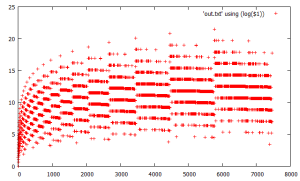
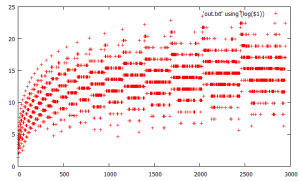
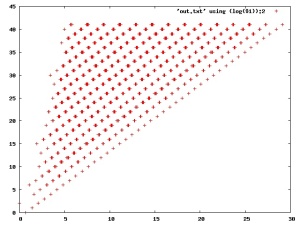

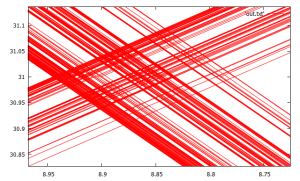
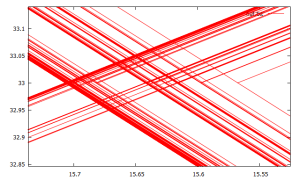
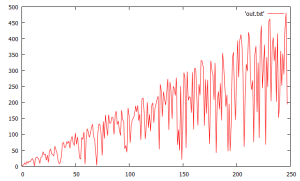
Consider the sets:
1. E = {2n: n is a natural No#.}
2. O = {2n+1: n is a natural No#.}
3. Ep = {2^n: n is a natural No#.}
4. Es = E – Ep
5. Op = {n: 3n+1=m where m is an element of Ep}
6. Os = O – Op
Example of the sets:
1. E = {2,4,6,8,10,12,14,16,18,20,22,…}
2. O = {1,3,5,7,9,11,13,15,17,19,21,…}
3. Ep = {2,4,8,16,32,64,128,256,…}
4. Es = {6,10,12,14,18,20,22,24,…}
5. Op = {1,5,15,21,85,341,1365,…}
6. Os = {3,7,9,11,13,17,19,23,…}
Now let the first number to the function of Collatz’ conjecture be:
a) n an element of Ep, then it will be evident that all f(n) are elements of Ep
b) n an element of Op, then it will be evident that all f(n) are elements of Ep
c) n an element of Os, then it will be evident that at least one f(n) is an elements of Es
d) n an element of Es, then it will be evident that at least one f(n) is an elements of Op
Conclusion to the comment:
• If a, b, c, and d are true then so is the Collatz conjecture true for every natural No#.
Consider numbers that are not of the form 3+4k. 5, 9, 13, 17, 21 etc. These all start with ×3+1, and then ÷2, ÷2. Which means, first we multiply by 3, add one, and then divide by 4. It’s a pattern. So, we don’t need to check these, because if number we are checking gets to a point in the sequence where a number appears lower than our starting number (the one we are checking) we know it goes back to one, because we already checked the number below that. 5 -> 16 -> 8 -> 4 -> done. 9 -> 28 -> 14 -> 7 -> done. 13 -> 40 -> 20 -> 10 -> done. 17 -> 52 -> 26 -> 13 -> done. 21 -> 64 -> 32 -> 16 -> done. etc. The numbers of form 3+4k are not like that. The numbers of form 3+16k have a pattern too. Consider numbers of the form 3+16k. 3, 19, 35, 51, 67 etc. These all start with ×3+1, and then ÷2, then ×3+1, then ÷2, ÷2, ÷2. Which means, we multiply by 6, and divide by 8 (and add 2 down the road), which get the value below starting value. It’s a pattern, thus, we don’t need to check these either.
If what I say is true, one only needs to prove two things. 1) That all numbers, excluding the ones of form 3+4k, but including the ones of form 3+16k, are always going towards 1; 2) That all numbers of form 3+4k end up, somewhere down the sequence, on a value not of form 3+4k.
Thanks for this post.
The 3x+1 conjecture is one of my favorites. I try to never think about it. I did try to prove there were no cycles when I was in grad school. No luck of course.
Thanks
⭐ ❗ 😮 😀 😎 ❤ wow RJL thx so much for dropping by, makes my day. am a huge fan of your blog and have commented many times over the years, and iirc have linked (somewhere!) to your great/ humorous post on subj "mathematical diseases". https://rjlipton.wordpress.com/2009/11/04/on-mathematical-diseases/
have you ever considered using stackexchange more? eg the chat capability? think of it like "micro blogging". think we could get some great dialog/ discussion going sometime and you might find it a fun way to interact with your audience, maybe even a source of some synergy/ inspiration, it defn has been for me over the yrs. found this user yrs ago, is it you? https://cstheory.stackexchange.com/users/2825/dick-lipton